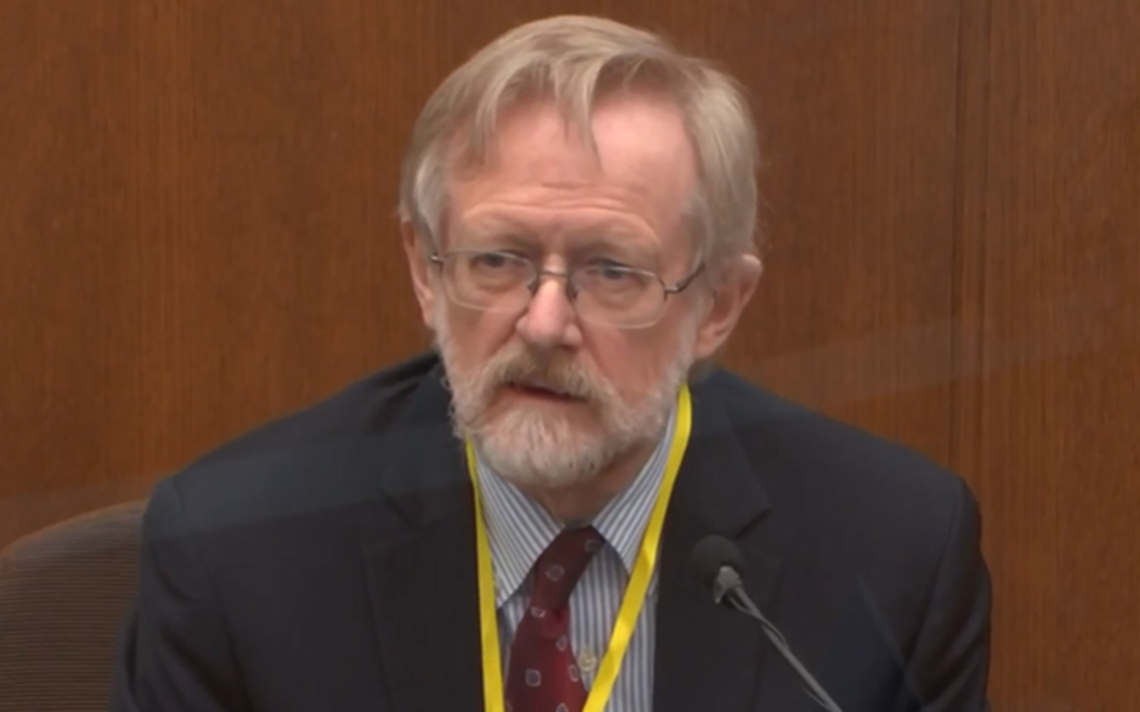

By Max Kennedy and Jose Medina
Minneapolis, MN – Court analysts are calling the testimony of Dr. Martin Tobin—Thursday’s Day 9 expert witness in the Derek Chauvin murder trial for killing George Floyd—the most damaging yet for the former cop.
Tobin, a pulmonology and critical care specialist, used visual aids, including re-creations and his experience as a lung doctor to support his view that George Floyd “died from a low level of oxygen.”
He absolutely, despite prodding by the defense, ruled out drugs in Floyd’s system, and the victim’s health as the cause of death.
Tobin, an award-winning doctor who has published extensive research on the mechanics of breathing, pointed to four factors which limited Floyd’s ability to breathe: lying prone on the street, being handcuffed tightly behind the back, having a knee placed on his neck, and having a knee placed on his back.
The doctor said the combined effect of these factors was so severe it was comparable to having a lung removed.
“It was almost to the effect as if a surgeon had gone in and removed the lung. Not quite, but along those lines. So there was virtually very little opportunity for him to be able to get any air to move into the left side of his chest,” Tobin said.
Prosecutors used the testimony in an attempt to draw a clear, causal link between Chauvin’s actions and Floyd’s death, both by emphasizing how Chauvin’s knee restricted airflow, and by  establishing the cause of death as lack of oxygen, rather than a heart attack or drug overdose.
establishing the cause of death as lack of oxygen, rather than a heart attack or drug overdose.
According to Dr. Tobin, Chauvin’s knee placement prevented Floyd from expanding his chest, which is necessary for breathing.
“The way they were pressing into his back, there was no way he could do any front to back (chest) movement,” said Tobin, after describing such movement as fundamental to breathing.
Tobin went on to estimate that Floyd lost over 40 percent of his usable lung volume due to the incident, noting that breathing in that position would be “enormously more difficult” than attempting to breathe through a straw.
The prosecution also used the testimony to take explicit shots at competing theories for the cause of death which could favor the defense.
Prosecutor Jerry Blackwell asked Dr. Tobin about fentanyl, which he ruled out as a major factor, noting, “With fentanyl, his respiratory rate should be down at about 10, instead his was normal at 22,” said Tobin. “A healthy person subjected to what Mr. Floyd was subjected to, would have died.”
Dr. Tobin analyzed bystander videos, the autopsy report and Floyd’s medical records to reach his opinion. He agreed he spent possibly thousands of hours studying the case, which he did without charging a fee because he felt it was an “important” case.
He pointed to the movements of Floyd’s fingers, shoulders, and neck to demonstrate Floyd’s difficulty breathing and reduced oxygen levels.
Dr. Tobin also pointed to a sudden extension of Floyd’s leg as evidence of a myoclonic seizure. “We see and we can tell from the movement of his leg that the level of oxygen in his brain has caused what we call a myoclonic seizure activity,” he said.
Tobin also testified against potential competing medical theories that could favor the defense, criticizing past studies that found kneeling on a prone person could be low risk, as well as the idea that “if you can speak, you can breathe.”
Dr. Bill Smock was the final witness called to the stand for the day. He is an emergency medical physician with his specialty being in forensic medicine. The state of Minnesota contracted him to review footage of the incident, Floyd’s autopsy reports, and Floyd’s medical records.
When Blackwell asked what his opinion was based on everything that he reviewed, Smock responded that Floyd died from positional asphyxia and elaborated, “which is a fancy way of saying he died because he had no oxygen left in his body.”
He then revealed to the court that he had ruled out two other explanations for the cause of Floyd’s death, which were excited delirium and fentanyl overdose.
Dr. Smock explained that excited delirium “is a physical and psychiatric state where because of an imbalance in the brain a patient will experience multiple symptoms such as heart rate is up, superhuman strength, speech is garbled, unaffected by pain, and can’t answer questions appropriately.”
He noted that this diagnosis did not align with Floyd’s behavior at the time of the incident, as he showed no acts of superhuman strength since “he was not able to throw those police officers that held him on the ground off himself.”
He added, ”Floyd did experience pain because we hear Floyd complaining of pain on his chest, neck, and back.”
Dr. Smock made it clear that a review of footage showed Floyd being able to “answer appropriate questions and giving appropriate answers” and that Floyd’s speech was clear and not gargled like someone under excited delirium would be.
Smock then explained why he ruled out a fentanyl overdose as the cause of Floyd’s death by defining what a fentanyl overdose would look like in a person.
He explained that a person experiencing a fentanyl overdose would die “because it will cause their respiratory rate to go to nothing, they would seize to breathe, they are not alert, and begin to sleep.”
When it comes to diagnosing someone with a fentanyl overdose, Dr. Smock made it clear that you cannot make that determination simply by looking at the fentanyl levels in a person’s system.
He stated that “you have to look at that patient in front of your eyes and ask, are they awake or getting sleepy and are their breathing rates going down?”
Dr. Smock further debunked the relevancy of Floyd’s fentanyl levels by revealing that “this fentanyl level was 11 and methamphetamine level was 19 which were all measured by nanograms per milliliters.”
He made it clear that Floyd’s methamphetamine levels were “ recreational use levels, they were nothing levels” and that based on medical records Floyd had a tolerance for fentanyl and that those fentanyl levels were not enough to get him to perceive the high.
Dr. Smock reiterated the fact that Floyd did not demonstrate any symptoms of fentanyl overdose by saying that Floyd was not sleeping in the videos—he was alert and “was giving appropriate responses, he knew where he was at and what situation he was in.”
Smock provided further evidence to Floyd’s consciousness at the time of the incident by pointing out “when we watch the video of the officer telling Floyd to go to the sidewalk and sit down he absolutely complied“ thus disproving the fentanyl overdose explanation.
He then mentioned that Floyd exhibited air hunger, which Smock elaborated as a strong desire to breathe.
He gave an example saying “someone who is being strangled, when their airway is being cut off and they can’t breathe their body is telling them to breathe but they can’t because of the pressure on their airway, that is air hunger, that is the human desire to live, to breathe.”
Wanting to make it clear that Floyd did not die of a fentanyl overdose but of asphyxiation, prosecutor Blackwell made the effort to show Floyd had signs of air hunger.
B;ackwell inquired of the witness, “So when George Floyd is heard saying ‘Please! I can’t breathe, I can’t breathe!’ is that an example of air hunger?”
Dr. Smock answered that Floyd’s pleas were definite signs of air hunger and that is made clear by his ”saying ‘please please get off me I want to breathe, I can’t breathe’—that is not a fentanyl overdose that is somebody begging to breathe.”
Blackwell then presented the court with body camera footage that depicted a closer look at Floyd’s reactions to Chauvin kneeling on him.
Dr. Smock explained to the jury what can be seen in the video, pointing out that “what we’re seeing here and if you listen his voice is getting gradually weaker he is telling the officers I’m about to die I can’t move.” He adds that “this is the progression of the body heading towards lower levels of oxygen.”
Smock then asked the jury to turn their attention to a red circle he drew around Floyd’s right handcuffed hand in the video. As the video played, the court could see how Floyd’s right hand pushed towards the tire he was next to and tried to lift up the right side of his chest.
He clarified that Floyd is “trying to bring his right side of his chest off the pavement so that he can take a breath of air.”
As the video continued to play, Dr. Smock advised that “as soon as Mr. Floyd was unconscious he should’ve been rolled over” adding that “here we have documentation of an officer saying I can’t find a pulse, but clearly when they couldn’t find a pulse CPR should’ve been started.”
 Max Kennedy graduated from Harvard in 2016 with a degree in History. He is an intern with the San Francisco Public Defender and most recently worked as a digital organizer with Joe Biden for President.
Max Kennedy graduated from Harvard in 2016 with a degree in History. He is an intern with the San Francisco Public Defender and most recently worked as a digital organizer with Joe Biden for President.
Jose graduated from UC Davis with a BA in Political Science and has interned for the California State Legislature. He is from Rocklin, CA.
To sign up for our new newsletter – Everyday Injustice – https://tinyurl.com/yyultcf9
Support our work – to become a sustaining at $5 – $10- $25 per month hit the link:




